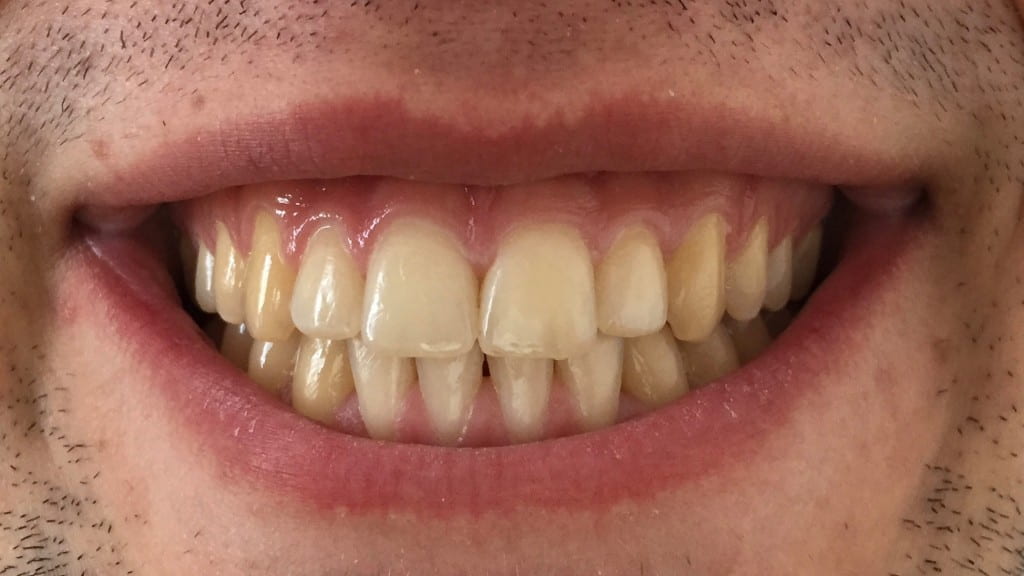
12 years is a long time to wait to be able to chew properly
By Adrian D’Alessandro, Class of 2016
Last Thursday I entered the final phase of a 12 year journey. It involved a medieval torture device, metal all over my teeth and my face getting cut open just so I could chew properly. Of course I’m being a bit melodramatic when I say medieval torture device, but I’m not the only person to make this observation.

Expander and Headgear
When I was 10 I had a Rapid Palatal Expander (RPE). This was a device attached to the roof of my mouth that would actually widen my palate. Every night for a month I had to use a special key to turn a little mechanism which would widen the device by a tiny amount. Think of a medieval torture rack stretching you out turn by turn, but it happens so slowly you barely even feel it.
Why do this? My top jaw was growing much more slowly than my bottom jaw. The most obvious symptom of this was my significant underbite (also called a Class III Malocclusion). Also, my top jaw was narrower than my bottom jaw, so my top teeth were biting on the inside of my bottom teeth. One amusing side effect was my two front teeth being separated so much that I could fit a $2 coin between the two of them.
Interestingly, the RPE only works on children. The growth plate in your upper jaw has a gap, called the midpalatal suture, that fuses in your mid teens. So children and young teenagers can use the RPE to expand their upper jaw before it fuses.
After the expanding was done, I needed a headgear that attached rubber bands to the RPE (which was attached to my back molars). This was designed to pull my top jaw forward, to encourage it to grow forward and overtake my bottom jaw.
Try as it might, the headgear never managed to pull my jaw far enough. So, another approach was taken.

Braces
The RPE was removed and the braces came on. Ouch.
While the RPE is akin to a medieval torture device, and heaps of teenagers have braces at some stage in their life, braces are far more painful.
Metal brackets are cemented onto your teeth and a single wire is threaded through each of them. This wire is quite stubborn, and REALLY wants to stay in it’s original shape, like a spring. This constant pressure on your teeth signals your body to do something about it.
Braces actually cause you jaw bone to dissolve and reform. The root of your tooth tunnels through your jaw bone like a worm through dirt.
Teeth are socketed in your jaw bones, with the Periodontal Ligament (PDL) acting as both a cushion and a glue between the tooth and the bone. The PDL is what senses the pressure and tells the jawbone to make a change. The bone starts to create osteoclasts – which are a kind of bone cell that breaks down the surrounding bone – to relieve the pressure and the tooth can start moving into the space created. This then creates tension on the other side of the tooth, so the PDL signals to the jaw bone to start making osteoblasts – a cell that creates more bone – to fill in the space behind it.
Suffice to say, they worked. By the time I was 13, my teeth were perfect. Off came the braces, in came the retainer.
Then, I had a growth spurt.

Surgery
My lower jaw grew about 1cm more than my top jaw. I had a pretty severe underbite. The orthodontist told me the only way to fix it was with surgery, but I would have to wait until I stopped growing.
By the time I was 21, scans told me I had stopped growing (much to my dismay, being less than half an inch short of 6 foot). So it was time for braces again!
The braces are required for the surgery as anchors, especially for the few weeks after when the jaw is healing. The surgery itself is quite incredible. The bottom jaw has a little chunk cut out and is then moved back. The top jaw is also moved forward, in a much more complicated way. In addition to both jaws being moved, I had all 4 wisdom teeth removed.

I was in hospital for 2 nights, and wasn’t allowed to eat solid food for 2 weeks. Other than the inconvenience of missing out on Christmas dinner, I was back to normal within a month. Apart from the swelling, which took about 6 months to fully disappear, and a numb chin.
There was about 10 months of adjusting the braces before they came off. Now they’re gone, and I can finally begin to put this whole saga behind me!
I can now chew things properly and have no metal attached to my teeth. I just need to remember to wear my retainers regularly so those osteoblasts can heal the jaw bone with my teeth in the right spot.